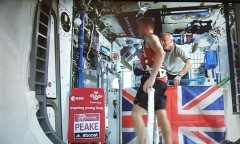By Steve Pak, | April 30, 2016

Puma's BeatBot
Puma's new training robot is a running companion that follows lines around a track at any speed the user wants. BeatBot was developed by a National Aeronautics and Space Administration (NASA) robotics engineer, Massachusetts Institute of Technology (MIT) students, and the shoe company's ad agency. The self-driving fast robot can even match sprinter Usain Bolt's 2009 world record of 22.7 miles per hour (44.6 kilometers per hour)
Like Us on Facebook
Puma's robot works by using an array of nine infrared sensors to scan lines on the running track, according to Engadget. The shoebox-like machine makes more than 100 adjustments each second to keep up with the professional runner.
Meanwhile, Arduino software monitors wheel rotations to keep track of speed and distance. The runner's gadget also includes dual GoPro action cameras and LED lights on the back.
Puma has not announced any price point for BeatBot. However, the fact that it will only be available to the German company's sponsored athletes and teams suggests it will be exorbitant and not for casual runners.
Puma's ad agency is J. Walter Thompson (JWT) New York. JWT executive creative director Florent Imbert shared that individuals' experiences and some studies showed that head-to-head competition boosted performance levels, according to The Verge.
However, Imbert added that the results were a result of human nature. Running against a person or thing seems to motivate runners more than an invisible clock.
In related news, Stanford University researchers have built a two-handed humanoid robot that can replace human pilots during dangerous underwater trips. OceanOne is a human-like bot that uses "haptic feedback" to allow humans to feel objects that the robot touches.
OceanOne's first voyage was to the shipwreck site of La Lune, which sank near the cost of France in 1664. The new robot collected objects from the sunken ship.
OceanOne's main function is to help during underwater missions that are too risky for human drivers. The first unit is still a prototype, but Standard researchers hope that within time they can develop a team of robotic divers that are remotely controlled by human pilots at a safe distance away from the dangerous environment.
-
Use of Coronavirus Pandemic Drones Raises Privacy Concerns: Drones Spread Fear, Local Officials Say

-
Coronavirus Hampers The Delivery Of Lockheed Martin F-35 Stealth Fighters For 2020

-
Instagram Speeds Up Plans to Add Account Memorialization Feature Due to COVID-19 Deaths

-
NASA: Perseverance Plans to Bring 'Mars Rock' to Earth in 2031

-
600 Dead And 3,000 In The Hospital as Iranians Believed Drinking High-Concentrations of Alcohol Can Cure The Coronavirus

-
600 Dead And 3,000 In The Hospital as Iranians Believed Drinking High-Concentrations of Alcohol Can Cure The Coronavirus

-
COVID-19: Doctors, Nurses Use Virtual Reality to Learn New Skills in Treating Coronavirus Patients











